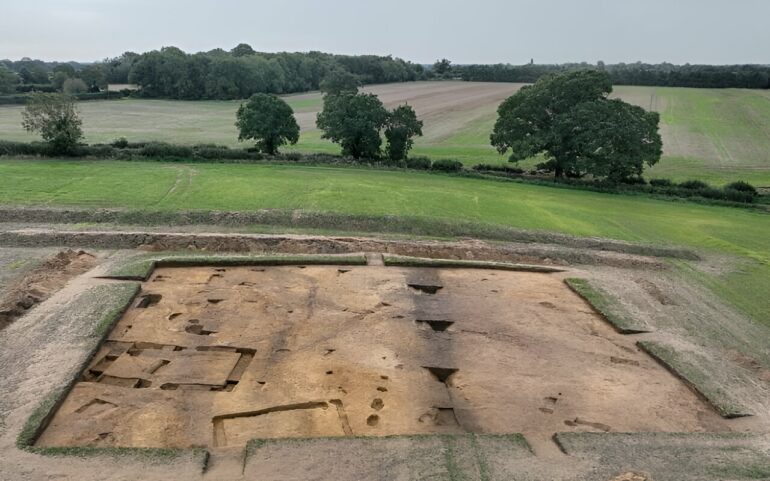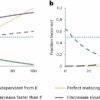A possibly pre-Christian temple from the time of the East Anglian Kings, some 1,400 years ago, has been found at Rendlesham, near Sutton Hoo in Suffolk, by a team of archaeologists led by UCL researchers.
The discovery was made over the summer by Suffolk County Council’s Rendlesham Revealed community archaeology project. Last year the project uncovered the remains of a large timber royal hall, confirming the location was a royal settlement of the East Anglian Kings.
This year’s excavations also uncovered evidence of fine metalworking associated with royal occupation, including a mold used for casting decorative horse harnesses similar to the one from the nearby princely burial ground at Sutton Hoo.
The royal compound is more than twice the size than had been previously thought. It’s bounded by a 1.5-kilometer-long perimeter ditch that encloses an area of 15 hectares, or the equivalent of about 20 football pitches.
The royal residence was part of a wider settlement complex covering 50 hectares, which is unique in the archaeology of 5th to 8th century England in its scale and complexity.
This year’s breakthrough caps a three-year campaign of excavation that challenged expectations and transformed understanding of the period.
The project’s principal academic advisor, Professor Christopher Scull (UCL Institute of Archaeology), said, “The results of excavations at Rendlesham speak vividly of the power and wealth of the East Anglian Kings, and the sophistication of the society they ruled. The possible temple, or cult house, provides rare and remarkable evidence for the practice at a royal site of the pre-Christian beliefs that underpinned early English society.
“Its distinctive and substantial foundations indicate that one of the buildings, 10 meters long and 5 meters wide, was unusually high and robustly built for its size, so perhaps it was constructed for a special purpose. It is most similar to buildings elsewhere in England that are seen as temples or cult houses, therefore it may have been used for pre-Christian worship by the early Kings of the East Angles.”
The site at Rendlesham is identified as an East Anglian royal center by The Venerable Bede in his Ecclesiastical History of the English People. Bede records that King Redwald, who died c. AD 625 and whose grave is thought to be the Sutton Hoo ship burial, maintained a temple in which there were altars to pre-Christian Gods alongside an altar to Christ—although he does not specifically say this this was at Rendlesham.
This summer’s excavations also revealed:
The foundations of three new timber buildings (including the probable cult house, or temple)Evidence of 7th century metal working, including the discovery of waste products and a fired clay mold to make decorative horse harnessesTwo graves of unknown dateEnclosures and evidence of earlier settlement and activity from the Neolithic (fourth millennium BC), Bronze Age, Iron Age and Roman periodsA Second World War searchlight emplacement.
These archaeological discoveries show that Rendlesham has been a favored location for human settlement and activity for 6,000 years from the fourth millennium BC to the present day, but that it was most important when a royal center during the 6th to 8th centuries AD.
The most recent archaeology encountered was a Second World War searchlight emplacement, part of a searchlight battery recorded on U.S. Air Force aerial photography from December 1943.
Suffolk County Council’s Deputy Cabinet Member for Protected Landscapes and Archaeology, Councillor Melanie Vigo di Gallidoro, said, “This year’s findings round off three seasons of fieldwork which confirm the international significance of Rendlesham’s archaeology and its fundamental importance for our knowledge of early England.
“Everyone involved in the project can take pride that together we have achieved something remarkable. Over 200 volunteers from the local community were involved this year, bringing the total number of volunteers to over 600 for the three-year fieldwork program, including from the Suffolk Family Carers, Suffolk Mind, and local primary school children from Rendlesham, Eyke and Wickham Market.”
Excavations are now complete and the trenches at the site backfilled, with work already underway to analyze the finds with provisional results forthcoming in 2024.
Provided by
University College London
Citation:
A 1,400-year-old temple discovered at Suffolk royal settlement (2023, November 24)



